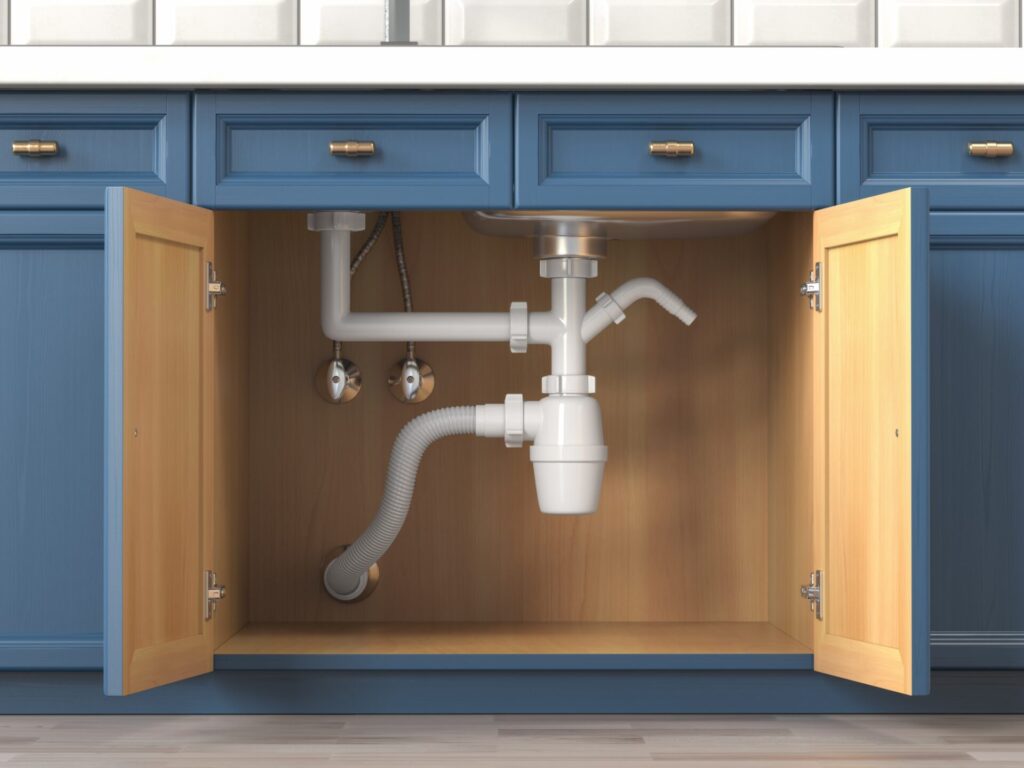A well-designed drain system is crucial for maintaining functional and efficient kitchen plumbing. In this blog, we’ll dive into the working parts of kitchen plumbing, explain how a kitchen drain design works, and discuss how a dishwasher relates to a kitchen sink.
The Working Parts of a Kitchen Plumbing Sink System
The kitchen sink system comprises several key components, including the faucet, supply lines, and shut-off valves. The faucet is responsible for delivering hot and cold water to the sink, while the supply lines connect the faucet to the water source. Shut-off valves allow you to control the water flow and shut off the water supply when necessary, such as during repairs or emergencies.
Drainage System
The drainage system consists of the sink drain, garbage disposal (if applicable), p-trap, and drainpipes. The sink drain is where the water exits the sink, while the garbage disposal grinds up food waste to prevent clogs.
The p-trap is a curved section of the drainpipe that holds water, creating a seal to prevent sewer gases from entering your home. The drainpipes connect the p-trap to the main sewer line, carrying wastewater away from your kitchen.
How Does a Kitchen Drain Design Work?
A well-designed kitchen drain system ensures that wastewater flows smoothly from your sink to the main sewer line. Here are the key elements of a kitchen drain design:
Proper Slope
- A kitchen drain system relies on gravity to move wastewater from your sink to the main sewer line.
- Drainpipes must be installed with a proper slope, typically a 1/4-inch drop per foot of horizontal run.
- This slope prevents water and waste from pooling or causing clogs, allowing them to flow smoothly through the pipes.
Ventilation
- Ventilation is crucial for maintaining proper drainage in your kitchen sink.
- Vent pipes allow air to enter the drainage system.
- Without proper ventilation, vacuum pressure can build up, slowing down the flow of water and causing issues like slow draining or gurgling sounds.
Cleanouts
- Cleanouts are access points in the drainpipes that allow for the removal of blockages and regular maintenance.
- They are usually near the sink, garbage disposal, and where the drainpipe connects to the main sewer line.
- Including cleanouts in your kitchen drain design minimizes the risk of clogs and makes it easier to address any issues.
How Is a Dishwasher Tied Into a Kitchen Sink?
A dishwasher is connected to the kitchen sink’s drainage system, allowing wastewater to exit the dishwasher and flow into the main sewer line. This connection is made through two key components that work together:
- Dishwasher Drain Hose: A flexible drain hose runs from the dishwasher to the sink drain or garbage disposal to allow wastewater from the dishwasher to exit through the same drainage system as the sink.
- Air Gap: This small, cylindrical device is mounted on or under the countertop or sink to prevent contaminated water from flowing back into the dishwasher. Alternatively, looping the drain hose above the sink’s flood level can create a high loop.
Connect With Us
If you encounter any issues with your kitchen plumbing or need assistance with installation or repairs, don’t hesitate to contact the experts at Clements Plumbing Heating and Air in Lamar, MO. They are a team of experienced plumbers who can help keep your kitchen running smoothly. Schedule your service today!
